Advertisements
Advertisements
Question
Differentiate between resistances in series and parallel.
Solution
| Resistances in Series | Resistances in Parallel | ||
| 1 | In this type of connection, the resistances are connected one after the other such that the same amount of current flows through each resistance. | 1 | In this type of connection, the resistances are connected between two common points such that the potential difference across each resistor is the same. |
| 2 | For n number of resistors connected in series, the effective resistance RS is equal to the sum of the individual resistors. RS = R1 + R2 + R3 + R4+ …… Rn |
2 |
For n number of resistors connected in pparallel, the reciprocal of the effective resistance (Rp) is equal to the sum of the reciprocals of the individual resistances. `1/R_p=1/R_1+1/R_2+..............+1/R_p`
|
| 3 | The effective resistance in series combination is greater than the individual resistances. | 3 | The effective resistance in parallel combination is less than the individual resistances in the combination. |
| 4 | It is used to decrease the current in the circuit. | 4 | It is used to increase the current in the circuit. |
APPEARS IN
RELATED QUESTIONS
With a neat labelled diagram and derive the equation for three resistances connected in parallel.
An electric lamp of 100 Ω, a toaster of resistance 50 Ω, and a water filter of resistance 500 Ω are connected in parallel to a 220 V source. What is the resistance of an electric iron connected to the same source that takes as much current as all three appliances, and what is the current through it?
What are the advantages of connecting electrical devices in parallel with the battery instead of connecting them in series?
The equivalent resistance of the parallel combination of two resistors of 60Ω and 40Ω is _______.
A) 24Ω
(B) 100Ω
(C) 50 Ω
(D) 240Ω
Explain with diagram what is meant by the "series combination" and "parallel combination" of resistances. In which case the resultant resistance is : (i) less, and (ii) more, than either of the individual resistances?
A resistor has a resistance of 176 ohms. How many of these resistors should be connected in parallel so that their combination draws a current of 5 amperes from a 220 volt supply line?
An electric heater which is connected to a 220 V supply line has two resistance coils A and B of 24 Ω resistance each. These coils can be used separately (one at a time), in series or in parallel. Calculate the current drawn when:
(a) only one coil A is used.
(b) coils A and B are used in series.
(c) coils A and B are uses in parallel.
In the circuit given below:
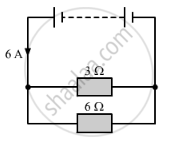
(a) What is the combined resistance?
(b) What is the p.d. across the combined resistor?
(c) What is the p.d. across the 3 Ω resistor?
(d) What is the current in the 3 Ω resistor?
(e) What is the current in the 6 Ω resistor?
The figure given below shows three resistors?
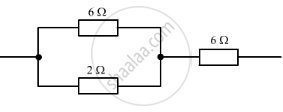
Their combined resistance is:
(a) `1 5/7`Ω
(b) `14` Ω
(c) `6 2/3` Ω
(d) `7 1/2` Ω
A wire of resistance R1 is cut into five equal pieces. These five pieces of wire are then connected in parallel. If the resultant resistance of this combination be R2, then the ratio `R_1/R_2` is:
(a) `1/25`
(b)1/5
(c)5
(c)25
Are the lights in your house wired in series?
In parallel combination of resistances ______.
A uniform wire with a resistance of 27 Ω is divided into three equal pieces and then they are joined in parallel. Find the equivalent resistance of the parallel combination.
An electrical appliance has a rating 100 W, 120V. The resistance of element of appliance when in use:
A current of 2 A is passed through a coil of resistance 75 Ω for 2 minutes.
(a) How much heat energy is produced?
(b) How much charge is passed through the resistance?
How does the resistance of a metallic wire depend on the length of wire?
In the figure below, the ammeter A reads 0.3 A. Calculate:
(i) the total resistance of the circuit
(ii) the value of R
(iii) the current flowing through R.
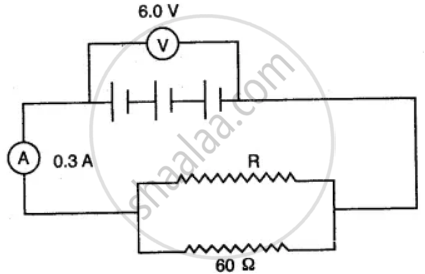
Calculate equivalent resistance in the following cases:
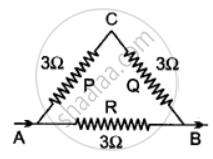
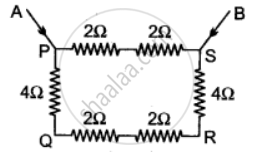
What connection is used in domestic appliances and why?
